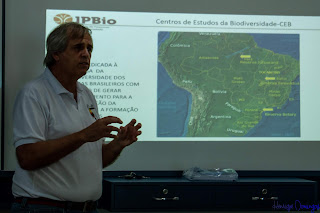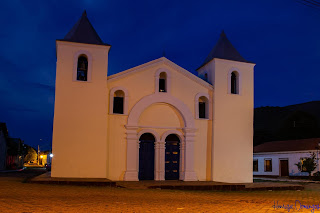Dia 17
Sérgio e
Val, com a ajuda de Raquel, organizaram uma reunião no escritório do Sebrae com
potenciais parceiros ou pessoas de interesse para a criação da nova reserva.
Isso incluiu pessoas de orgãos ambientais e do setor de turismo. Sérgio fez uma
apresentação sobre quem ele era, seus planos para a criação de uma reserva e
centro de pesquisa na região, bem como o desenvolvimento de um zoológico em
estilo de safári onde a macrofauna, como emas, tamanduás e o famoso lobo Guará,
poderiam ser mantidos para os visitantes verem. Ele abriu para feedback e fez
perguntas para obter a perspectiva dos habitantes locais. Uma grande
oportunidade surgiu nesta discussão, pois havia uma clara necessidade de um
centro de reabilitação e soltura na região. Atualmente um animal necessitado de
ajuda teria que ser transportado para Palmas, que é muito distante, o que seria
estressante para os bichos. Após a apresentação, atravessamos a cidade mais
próxima da reserva, Rio da Conceição, e fomos a parte inferior da reserva para
visitar o terreno.
A reserva é
naturalmente dividida em uma seção superior, como vegetação clássica do
Cerrado, onde ficará a infra-estrutura, como alojamento o centro de pesquisa e
o safari. A seção inferior, é uma floresta de galeria ao longo do rio com vegetação
de especies da Mata Atlântica e da floresta Amazônica mantidas pela maior
umidade e fertilidade do solo. Nesta área foram encontradas uma cachoeira e uma
caverna. A ligação entre essas duas seções com cerca de 150 metros de diferença
de altitude é feita por uma trilha que foi recentemente criada. Para os mais
aventureiros (Henrique), há um percurso pela floresta que passa por várias
outras cachoeiras e tem partes onde é preciso nadar e escalar para passar.
Neste dia,
visitamos apenas a parte inferior, começando por atravessar uma ponte
improvisada que oscila mais do que a maioria gostaria. Passamos pelo terreno do
Lindomar, vizinho que tem uma pequena casa de adobe (tijolos modados a mão com
barro e capim) onde ele fica quando quer fugir de sua casa na cidade. Logo
chegamos à caverna em que entramos. A caverna ainda não tinha sido mapeada. Olhamos
para dentro de um burraco até a parte inexplorada da caverna onde havia
milhares de morcegos e decidimos que hoje não era o dia para mapeá-la.
Continuamos caminhando e vimos várias centopéia descansando sob uma grande
colônia de cogumelos, que provavelmente come. Henrique recolheu uma centopéia
para ver se ela brilharia sob a luz UV. Imran viu o que inicialmente se pensava
ser uma Araponga, devido à sua vocalização similar, que na Mata Atlântica é
toda branca com uma cara azul. No entanto, depois de inspecionar o vídeo
capturado, ele percebeu que não era a araponga comum. Este pássaro era branco
com asas negras e uma cara marrom e tinha uma pele flácida na garganta muito
peculiar. Nem o Henrique conseguiu identificá-lo, mesmo tendo consultando seu
livro "Aves do Cerrado". Mais tarde, descobrimos que era uma araponga
do nordeste, extremamente rara, com apenas 16 fotos registradas no WikiAves (a
maioria dos pássaros tem milhares nesse banco de dados).
Chegamos à pequena
cachoeira no final da trilha, onde vimos um sapo nadando em uma pequena piscina
natural. Voltamos ao carro e saímos da reserva para visitar uma grande
cachoeira chamada "Cavalo Queimado". No caminho, todos discutimos o
nome estranho. Finalmente, Caco recebeu a explicação que ele tanto desejava de
um dos guias que é mais ou menos assim. Tribos indígenas viviam nessa área e
criavam gado. No entanto, eles perceberam que regularmente uma de suas vacas
desaparecia de um dia para o outro. Eles deixaram um vigia uma noite para ver o
que estava acontecendo e descobriram que um grupo de baianos sempre vinham
roubar seu gado. Um dia eles atearam fogo na floresta ao seu redor. Os Baianos
conseguiram escapar, mas deixaram seus cavalos amarrados à árvore. Daí surgiu o nome Cachoeira do Cavalo Queimado.
Day 17
Sérgio and Val, with the help of Raquel, had organized
a meeting at the Sebrae Office with potential partners or people of interest
for the creation of the new reserve. This included people from environmental
organs and the tourism sector from the region. Sérgio gave a presentation about
who he was, his plans for the creation of a reserve and research center in the
region as well as the development of a safari-style zoo where macrofauna, like
Emus, anteaters and the famous Guara Wolf, could be kept for visitors to see.
He opened up the for feedback and asked questions to get the perspective of the
locals. A big opportunity emerged in this discussion as there was a clear need
to a rehabilitation or release centre in the region as currently an animal in
need of help would have to be transported to Palmas which was very far away
which would be stressful for the animals. After the presentation everyone drove
passed the closest town to the reserve called Rio da Conceição and over to the
bottom section of the reserve to visit the terrain.
The reserve was split into a top section which was
classic Cerrado vegetation where the infrastructure like housing and the safari
would be located and the bottom section which was Atlantic Forest vegetation
where a waterfall and cave were found. The climb between these two sections was
about 150 meters difference in altitude which would be done through a trail
which was recently created or for the more adventurous (Henrique) could be done
through the forest which passed through various other waterfalls and had parts
where you had to swim and climb up waterfalls to get passed.
On this day we only visited the bottom section which
started by crossing an improvised bridge which wobble more than most would
like. We passed Lindomar, the owner of the neighbouring plot of land who was a
kind gentleman who had joined us for the presentation, little mud house where
he stayed when he wanted to get away from his main house in town. Soon we came
to the cave which we entered and saw that through the narrow whole which
extended into the undiscovered part of the cave there were thousands of bats.
We continued walking and saw various millipedes resting under a large colony of
mushrooms, which it most likely eats. Henrique collected one to see if it would
glow under UV light. Imran spotted what was first thought to be a regular Araponga
or Bellbird due to its similar vocalization which in the Atlantic Forest was
all white with a blue face. However, after inspecting the video he captured he
realised that it was not the same as this bird had very strange flapping skins
on its throat and was white with black wings and a brown face. Not even
Henrique could identify it, he even checked in his book of “Bird of the
Cerrado” and couldn’t find it. It was later found to be a Bearded Bellbird
which is extremely rare, with only 16 photos registered in WikiAves (most birds
have many thousands in this database).
We reached the waterfall at the end of the trail where
we saw a frog swimming in a little natural pool. We returned to the car and
headed off the reserve to visit a large waterfall named “Burnt Horse”. On the
drive there we all discussed what a strange name that was. Finally, Caco got
the explanation from one of the guides he so badly wanted which goes something
like this. Indigenous tribes, known as “Indios” or Indians in common Brazilian
dialect, used to live in this area and raised cattle. However, they realised
that regularly one of their cows would go missing from one day to the next.
They left a watchman one night to see what was going on and they discovered a
group of Baianos, from Bahia, would always come to steal their cattle. One nigh
they set fire to the forest around them but the Baianos managed to escape but they
left their horses which were tied to tree. Hence the
name Waterfall of Burnt Horses.

































